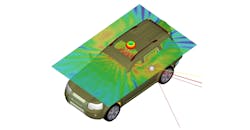Ansys, which sells popular tools for simulating and analyzing antennas, announced last week that it had acquired Computational Engineering International, whose software creates realistic views of simulation data destined to be logged in databases or plotted on graphs.
The company's flagship software, called Ensight, is used for computational fluid dynamics, which can replicate wind curling over car bodies and visualize chemicals swirling through an oil refinery. Ansys views that software as applicable to its entire product portfolio, including tools that predict how electromagnetic fields sprout from antennas.
Mark Hindsbo, vice president of Ansys' design and platform business unit, did not promise specific product changes in an interview this week. But he offered examples of what could be done with Ensight integrated into electromagnetic tools like HFSS, which uses mathematical programs called solvers to flag emissions and coupling issues.
For example, engineers could clearly see how antennas inside drones react to pockets of interference and wireless dead zones. The visualization tools could make it easier to assess how antennas installed on cars cope with interference in cities. Hindsbo said that some partners had already used Ensight and Ansys electromagnetic solvers together.
“But that is not a product plan, not something we are going to ship tomorrow,” Hindsbo said, adding that both companies were meeting this week to discuss what simulation tools – other than those for computational fluid dynamics – could benefit from Ensight's visual prowess.
Ansys already runs post-processing on its simulation data, but it's far from what CEI's software can do. Going forward, the two businesses will plan products together closely, Hindsbo said.
Microwave and radio frequency engineering seems ripe for the Ensight treatment. As cars and factory equipment start chatting wirelessly, engineers are increasingly using simulation software for antenna prototyping and placement. But these simulations can generate terabytes of data, which CEI's software could make easier to understand.
CEI, which split from supercomputing firm Cray in 1994, has only 28 employees but more than 750 customers in markets like aerospace and automotive. The company sells software that turns complex data generated by simulations into animations that run in simulated real-world environments.
“The next generation of products will not be built without simulation up and down the product development cycle, from early concepts to digital twins that run until production,” Hindsbo said. CEI’s tools will help apply that data more intelligently and present it visually, so that both engineers and executives can grasp it, he added.
Ansys has already been moving toward simulating antennas in the virtual world. Two years ago, the company acquired Delcross Technologies, whose software lets users not only analyze individual antennas but also simulate how those parts can affect the ability of a smartphone or car to transmit and receive data.
“How do the electromagnetics change if you alter the layout of a fighter jet or car now that you are bouncing between geometry and electromagnetics and the environment?” Hindsbo said. “Those are places where you can speculate on the effects of visualization.”
Ansys – which last year generated $988.5 million from selling software used to design everything from rockets and bridges to wearables and airplanes – did not reveal the terms of the deal.
"Joining Ansys will give our customers access to the best engineering simulation technology on the planet, and EnSight will help Ansys users make faster, smarter decisions," said Anders Grimsrud, CEI's president, in a statement. "It's a win-win."
About the Author

James Morra
Senior Editor
James Morra is the senior editor for Electronic Design, covering the semiconductor industry and new technology trends, with a focus on power electronics and power management. He also reports on the business behind electrical engineering, including the electronics supply chain. He joined Electronic Design in 2015 and is based in Chicago, Illinois.
